The Thurn and Taxis Family
In 1490, European postal services were provided by the Thurn and Taxis family. In the 17th century, they introduced postal carriages. With that, they built a historical financial empire through the services they provided to Europe's entire population, meeting demands from kings, emperors, politicians and common people, like you and me.
More than 250 years of history connect the Thurn and Taxis family to the efficient postal services provided even today.
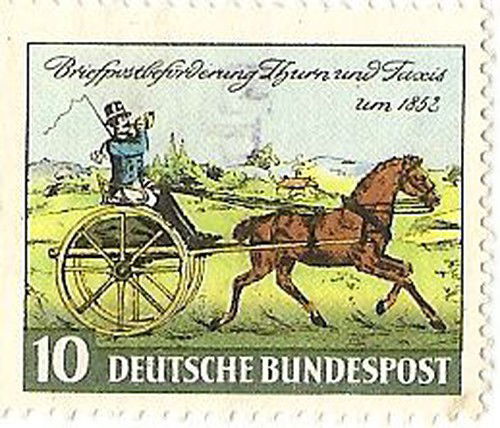
So, can you achieve what this family has achieved and build a successful postal network? Are you talented enough to connect the right cities, create an efficient network, and keep an eye on your need for new carriages whenever necessary? Welcome to Thurn and Taxis!
Game Data
Thurn and Taxis is a game played with 2 to 4 players, with an age recommendation of 10 years and up, from the couple Andreas and Karen Seyfarth. Andreas Seyfarth is also the designer of the game Puerto Rico (a classic), and its card version, San Juan. Michael Menzel is the artist responsible for the illustrations in this game, and was also responsible for illustrations in other Andreas Seyfarth games, including the ones listed above, among other famous classics such as Catan, Stone Age and Dominion.
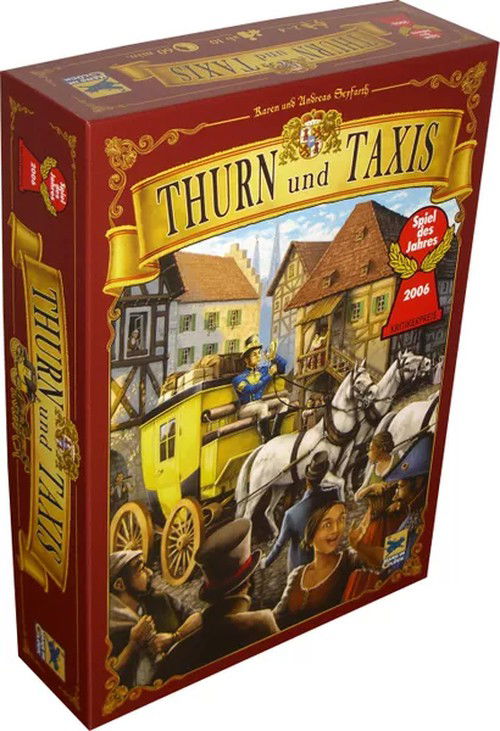
Thurn and Taxis was released in 2006 by Rio Grande Games. It uses mechanics such as hand management, collecting and building networks and routes. An important detail is: the game can be played regardless of the language.
Besides that, Thurn and Taxis is an award-winning board game: among its 19 awards in just 2 years, we can highlight Spiel des Jahres, awarded to it in the year it was created, considered the most important award in this game genre.
The Game
Thurn and Taxis is another one of those cool games based on real stories. I, personally, really enjoy that, because it is fun and can teach us a lot. The game translates well what the Thurn and Taxis family did in practice: create the most efficient postal service system in Central Europe.
This is our goal in this game. Obviously, when we compete with our opponents, other players will also be trying to achieve the same goal. Let's find out how we can build this empire!
The board brings Central Europe's map and shows connections between cities, as well as the other components used during the game, such as: route cards and carriage cards. It also introduces Postal Officials, and, as the game goes on, showcases the exact game state in this race to build the most efficient postal system.
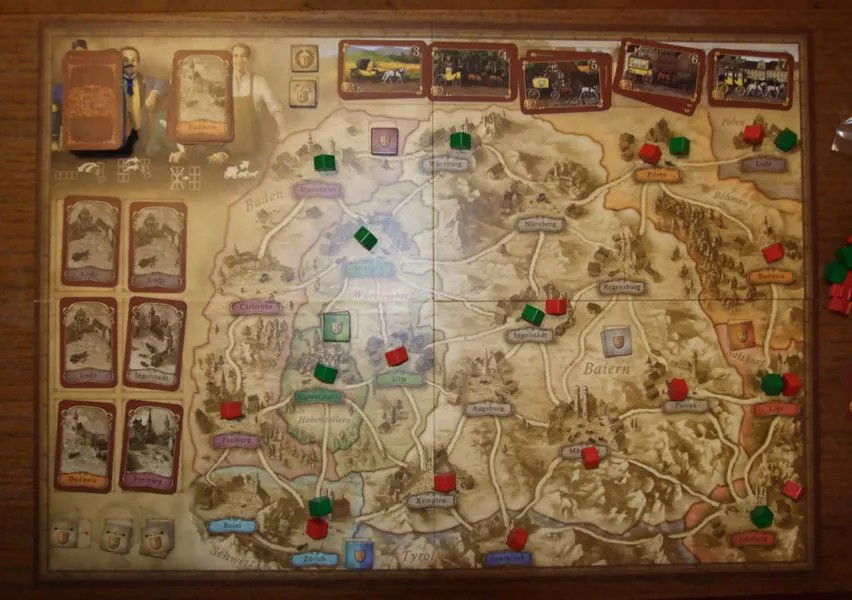
A player's turn is relatively simple. They perform 2 mandatory actions and 1 optional one. Let's see the details:
The 1st mandatory action will force players to get 1 (and only 1) out of the 6 route cards available so that they can then start or continue their route, after all, you start the game with no route cards. That's right! No cards. Do you think it's easy to build a postal empire?
Considering that, already on turn 1, you'll get help from one of the Postal Officials, the Postmaster, which allows you to get 2 cards from the 6 cards available. And what if the route cards available aren't good? Good question! You can then resort to the pile of "closed" cards.
From turn 2 onward, in this first mandatory step in the process, to resolve this issue with bad route cards, you can get help from another Postal Official, the Administrator, which allows you to swap all 6 cards available, and then, after that, choose one of them (or choose a "closed" card in its pile).
Be aware that you can only get help from 1 of the 4 Postal Officials per turn, and that on the 1st turn, by default, you'll get help from the Postmaster. The 4 available Postal Officials will be quite visible on the board's upper-left corner, with informative icons that easily resemble their roles.
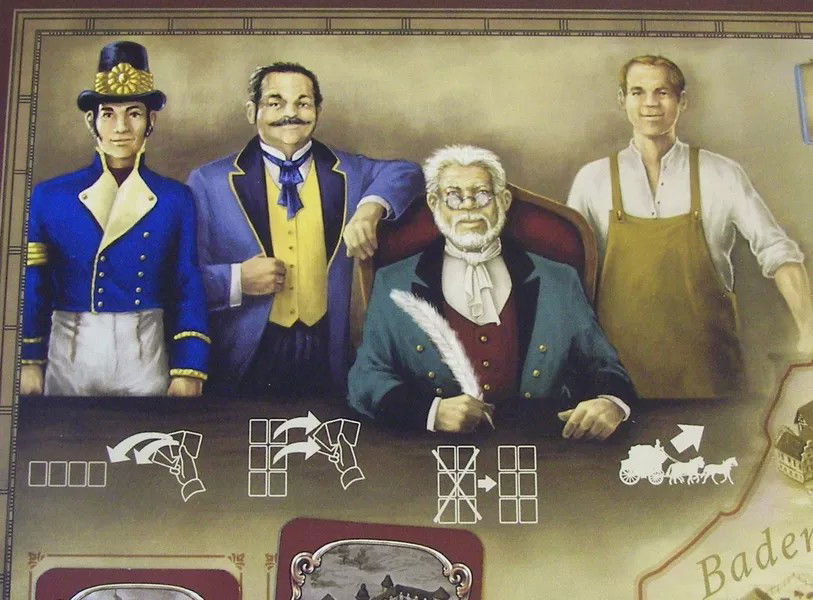
As the 2nd mandatory action, you must place 1 (and only 1) route card from your hand forward (play that card on the board) and start or continue a route. To achieve that, it is important to stress that to continue a route, you can only play route cards to the left or the right of cards you've already played, which means, you can't add a card to the middle of a route. That makes the game much more interesting and strategic.
And what if you don't have a card in hand to continue a route? Well, my friend, life is cruel. You'll discard all your route cards from the board (without adding anything to your score) and start a new route. Life goes on!
In this mandatory 2nd action, you can also count with the help of another Postal Official, the Postal Carrier, which allows you to play 2 route cards at once. That makes a lot of difference when you're briefly contesting a route before your opponents. Not that they can't play a postal office in that same place, but you can get the bonus before them, or the highest-value bonus.
As a 3rd action, and remember, this is optional, you can finish and add your route's score points (as long as it has at least 3 route cards in front of you on your board). This triggers the other 3 events.
You need to place postal offices, or houses, where your routes are, and that is a very important decision when you're adding your score. To achieve that, you should know that the map is divided into Provinces and each Province has several Cities. You have 2 options: place 1 postal office in a single City in each Province where your route goes through, or place 1 postal office in each City in a single Province where your route goes through.
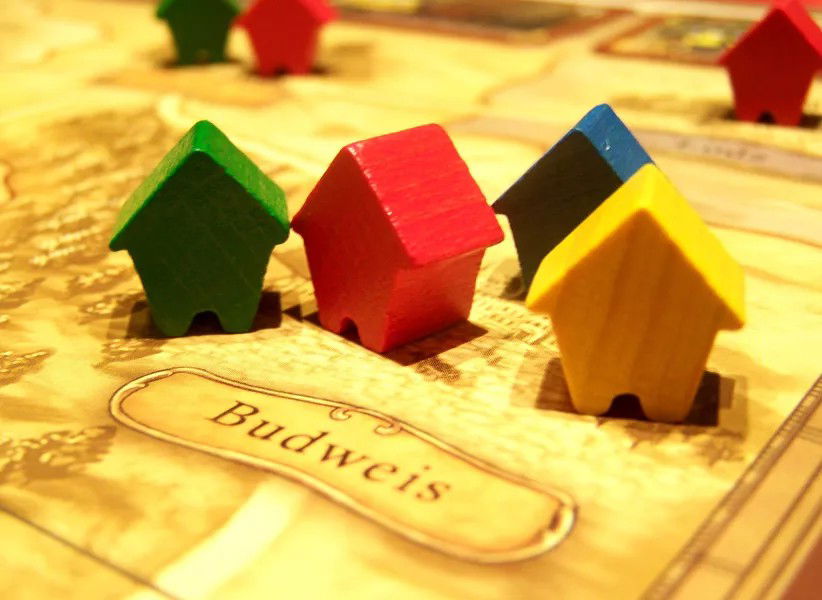
This choice is important, as you'll compete for bonuses if you get all Cities in a single Province, if you get at least one City in all Provinces, if you have the longest route, and so on and so forth. So, that explains why you need to consider the aforementioned two options regarding where you'll place your postal offices.
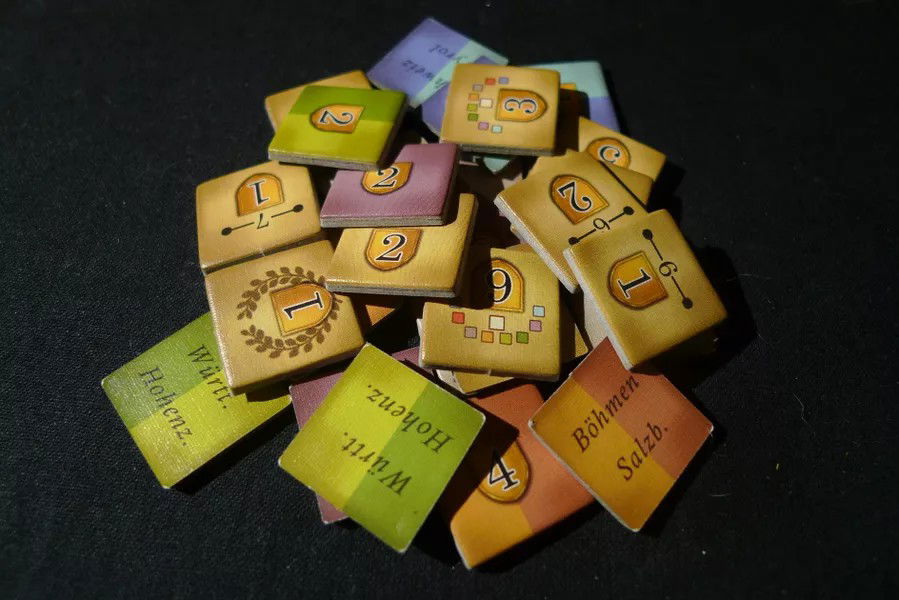
Well, before discarding the route cards used to add your points to your score, check if the size of your route is bigger or equal to the value of the highest-value carriage available (that you don't have), and acquire it. Keep in mind, you can't skip over the carriages' value even if your route is longer than the value of the carriage; you should respect it and acquire one by one, from the smallest to the biggest. This is a lesson on patience!
The carriage cards are crucial, because they can end the game, and the value of your biggest carriage counts as a point to your final score.
At this moment, we can, if we need to, count with the help of the 4th and last Postal Official, the Cartwright. If the size of your route is one or two cards smaller than the value of the next carriage you need to acquire, the Cartwright can help you (within this limit of 1-2 points).
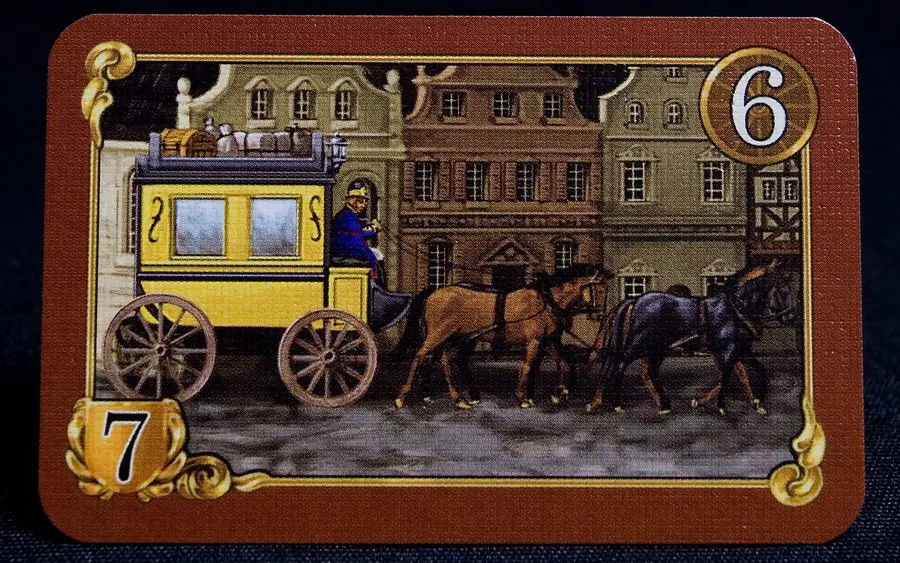
When finishing your turn, you need to discard the route cards used and more, discard all route cards from your hand until you have at most 3 cards. Yeah, adding points to your score has its consequences. Finally, just pass your turn to the player to your left. It's that simple!
That is a typical Thurn and Taxis turn.
End Game and Score
The game can be ended in 2 different ways: whenever a player acquires the highest-value carriage (7) or whenever a player puts their last postal office on the board. In both cases, the turn goes on to its end and then the game ends. Note: the player who ended the game gets an "end game" bonus token.
The scores are extremely easy to calculate, and are based on 3 steps: add your highest-value carriage card to your bonus tokens and subtract the number of postal offices you haven't used. Very simple!
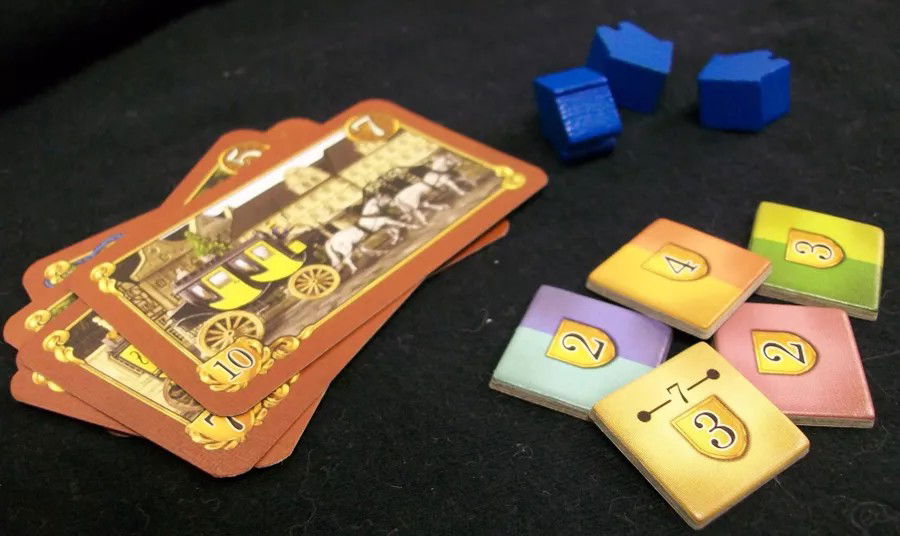
At the end, the player with the highest total points wins. If 2 or more players are tied, the player with the "end game" bonus token is the winner. If this player doesn't tie with the others, the tied player who is closer (clockwise) to the player with the "end game" bonus token is the winner.
Strategic Tips
Let's head right into it. The final score in Thurn and Taxis is quite simple to calculate: the highest-value carriage is added to the (possible) bonus tokens won, and the remaining postal offices in each player's hands are subtracted. From this point of view, it is easy to focus on what to do. Yeah, even though it is quite clear to see what counts as a point and what subtracts points, mixing these 3 factors requires strategy.
To get the best carriages, you have to match the value of your route with the value of the next carriage you want to get. Remember, you can't skip to the highest-value carriage straight away; you need to go by values - which means, always getting carriages from the cheapest one to the most expensive one, in order.
To achieve that, that means, adding your score and getting the best carriages, you'll depend on the route cards available when it is your turn. When everything seems to be in your favor, and your turn is near, someone might, before you, get that route card you were counting on. Or worse, sometimes there are even more than one copy of the route card you need, but your opponent then uses the Postal Official, the Administrator, and swaps all the cards, ending your chances. I'll confess it is annoying.
I strongly suggest you use the Administrator's help to swap route cards when the options you need aren't available, because trying your shot with the closed route card deck will only give you 1 option that is different from the other 6 available options. The Administrator will bring you 6 new route cards, and if you still don't like them, then, by all means, choose the closed route card deck and get a card from there.
Adding a route's points also requires strategy, because there are bonus tokens if you can get all Cities in a Province, if you get all Cities in 2 Provinces, or if you have at least 1 City in all Provinces, and so on and so forth, which means, which bonus will be your focus? It is an important decision, because they give out higher values to the players who are the first ones to score each type of bonus, which means, if another player is the first one to get a particular bonus, you can focus on another type of "first time bonus".
By the way, if you want to speed things up, ask the Postal Carrier for help, one of the Postal Officials. It allows you to play 2 route cards at once instead of only the 1 route card you're allowed to play in a turn. This move is particularly strategic when you notice someone has an eye on a bonus, and you want to get it before them.
Additionally, you can get a bonus per route length, which isn't something easy to get, because they require extremely long routes, which are obviously the harder ones. That makes sense considering you'll start the game without any route cards. Connected to that, you can only get 1 route card per turn, unless you get help from a Postal Official, the Postmaster, which allows you to get 2 route cards at once.
That is very useful when you plan ahead and identify among the route cards available 2 interesting cards to use straight away (or in the future) on that same route you intend to add to your score. Getting help from Postal Officials makes all the difference in the world.
Still on choosing your route's length and getting a carriage at the same time, don't forget the Carthwright, the last Postal Official. Nearly every time we're playing, we forget about them. The reason behind this is that they aren't needed "during" your turn, which means, they don't improve your card options, they don't make it easier for you to play more route cards, nor getting more than 1 route cards, which means, we often finish our turn and they aren't memorable. However, they can really help when we build a route smaller than we would need to get a carriage when we're missing 1 or 2 points on the route's length to acquire a new carriage - and that, besides being really impactful, can even end the game, look at that!
Notice that I'm giving you several tips on how Postal Officials can boost your turn, but don't forget: you can only count on their help once per turn. Yeah, figuring out whose help is best each time has never been more important.
Another thing you should consider is how fast you'll end the game. See, if you're too eager to draw your carriages, you'll end the game too soon. At times, you won't even have that many bonuses and will have many postal offices in hand, which means, you'll be behind your opponents when you add your score.
Knowing how to balance these aspects, and always keep an eye on the other players to know if they'll end the game, or are close to ending the game, is very important. I strongly recommend you put down as many postal offices as possible, focusing on the best bonuses available, and getting the best carriages.
Does it seem easy? Yeah, but it's hard to achieve considering all the possibilities, and that's why Thurn and Taxis is so challenging when it comes to strategy: everything is quite clear, but combining everything is the real secret.
It is quite a game!
Unboxing and Gameplay
To showcase this game a bit more, I added two videos below. The first one shows the game's components, and the second showcases some gameplay, and shows you how to play.
And now, how to play:
Teaching Tips
Thurn and Taxis is a lesson on geography and history at the same time. Exploring Central Europe's map through a real story is much more interesting than usual, with real places, cities, and historical buildings. After all, on the game's board and on the cards there are 22 illustrations depicting Europe's historical buildings, such as cathedrals, castles, town halls, fortresses, and others. You can take advantage of that to teach European culture.
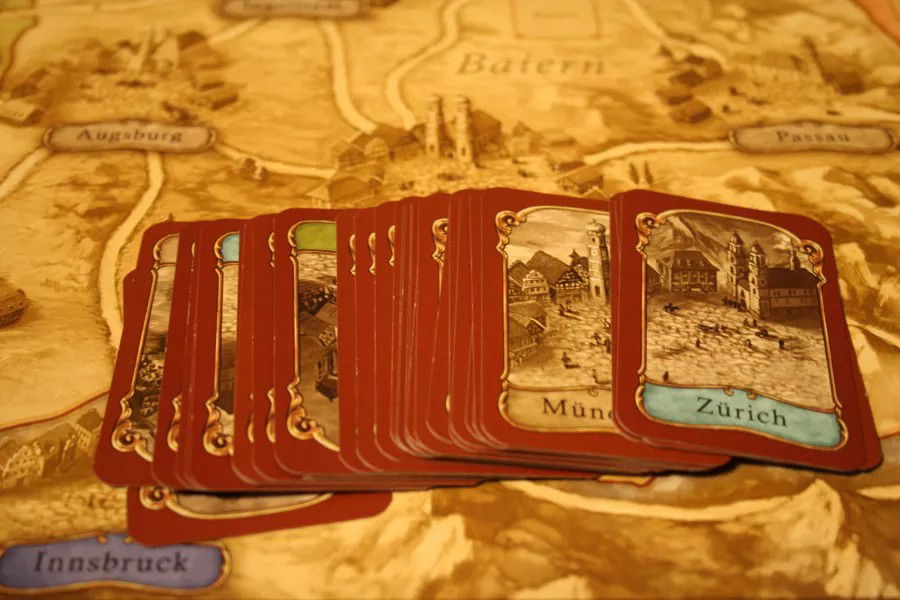
On the game's box we can find a document (besides the rules and other components) showing Thurn and Taxis' entire history, and images and names of all historical buildings. It is a true lesson on history!
Still regarding the game's teaching potential, we use math equations to check where you should place your next postal office to get more points, or a bonus.
You also use spacial awareness, because connecting routes on the map to score more and be more efficient is crucial, and requires care and strategy.
This game can bring a lot to its players!
I strongly recommend you add Thurn and Taxis to your collection!

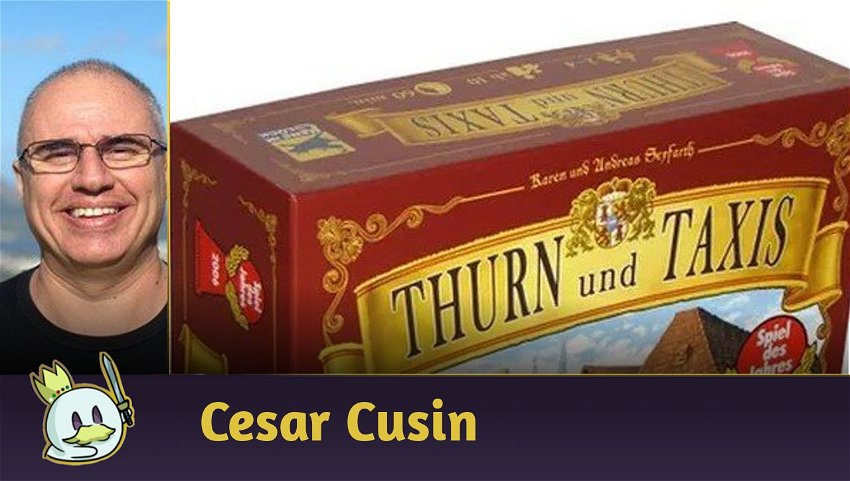







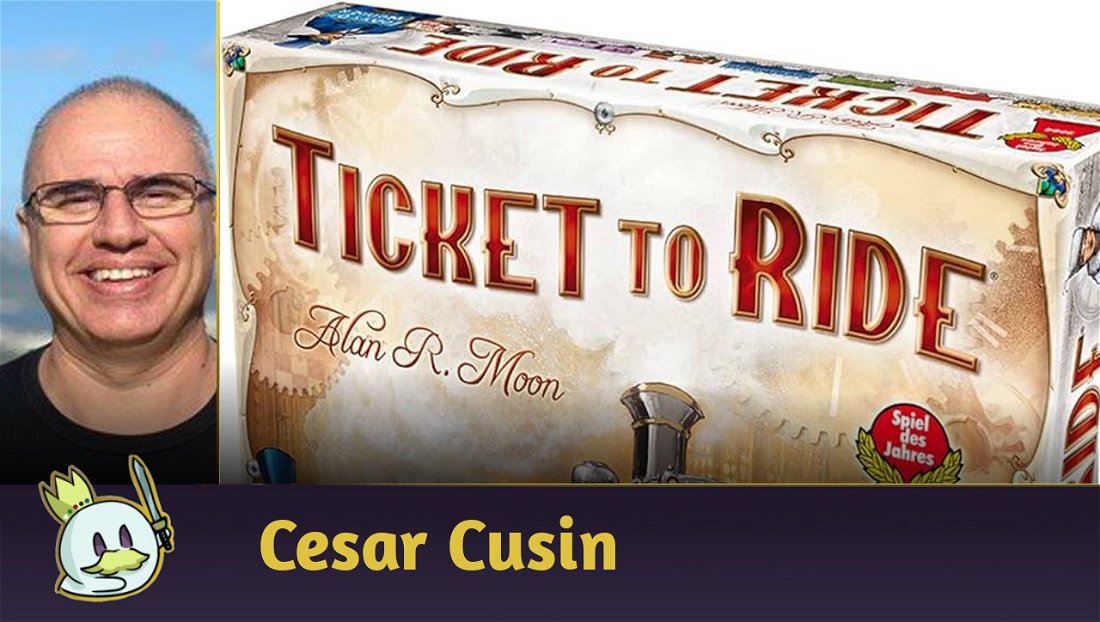




— Comments 0
, Reactions 1
Be the first to comment